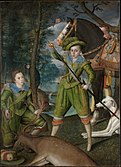Chartreuse (color)
| Chartreuse | |
|---|---|
(clockwise from top-left) Cardington Airfield, Catopsilia pomona, Portrait of the Prince of Wales by Robert Peake the Elder, Fire engine in Zürich, A Shot Glass of Chartreuse liqueur | |
| Hex triplet | #80FF00 |
| sRGBB (r, g, b) | (128, 255, 0) |
| HSV (h, s, v) | (90°, 100%, 100%) |
| CIELChuv (L, C, h) | (90, 123, 119°) |
| Source | RGB and CMYK color systems. |
| ISCC–NBS descriptor | Vivid yellowish green |
| B: Normalized to [0–255] (byte) H: Normalized to [0–100] (hundred) | |
Chartreuse (US: /ʃɑːrˈtruːz, -ˈtruːs/ ⓘ, UK: /-ˈtrɜːz/,[1] French: [ʃaʁtʁøz] ⓘ), also known as yellow-green or greenish yellow, is a color between yellow and green.[2] It was named because of its resemblance to the French liqueur green chartreuse, introduced in 1764. Similarly, chartreuse yellow is a yellow color mixed with a small amount of green, named after the drink yellow chartreuse.[3]
During the 2000s, yellow-green, as well as other shades of bright green like lime green, became very popular when various tech companies used it in office decor and other products, and with the popularity and success of the Shrek franchise.[4][5][6][7][8][9]
Shades[edit]
History and etymology[edit]
The name Carthusian is derived from the Chartreuse Mountains in the French Prealps: Bruno of Cologne built his first hermitage in a valley of these mountains. These names were adapted to the English charterhouse, meaning a Carthusian monastery.[a] These monks started producing Chartreuse liqueur in 1737.
In nature[edit]
Yellow-green algae, also called Xanthophytes, are a class of algae in the Heterokontophyta division. Most live in fresh water, but some are found in marine and soil habitats. They vary from single-celled flagellates to simple colonial and filamentous forms. Unlike other heterokonts, the plastids of yellow-green algae do not contain fucoxanthin, which is why they have a lighter color.
In popular culture[edit]
Traffic safety[edit]
Chartreuse yellow is used on traffic safety vests to provide increased visibility for employees working near traffic. The chartreuse yellow background material, together with a retro-reflective satisfy the ANSI 107-2010 standard since 1999. High-visibility clothing ANSI Standards were adopted as an Occupational Safety and Health Act (United States) requirement in 2008.[10][full citation needed]
Film and television[edit]
The 1960 Universal film Chartroose Caboose featured a "bright green"-colored train car.[11]
Firefighting[edit]

Since about 1973, a sort of fluorescent chartreuse green has been adopted as the color of fire engines in parts of the United States and elsewhere. The use of chartreuse fire engines began when New York ophthalmologist Stephen Solomon produced research claiming that sparkling bright lime-green paint would boost the night-time visibility of emergency vehicles compared to those painted the traditional fire engine red.[12][13] The reason for this is the Purkinje effect, i.e., the cones do not function as efficiently in dim light, so red objects appear to be black. In Australia and New Zealand this form of chartreuse yellow is also known as "ACT yellow" as this is the color of the fire engines in the Australian Capital Territory.
See also[edit]
References[edit]
Informational notes
Citations
- ^ "Chartreuse". The American Heritage Dictionary of the English Language. Houghton Mifflin/Yahoo! Inc. Archived from the original on June 8, 2008. Retrieved January 19, 2010.
- ^ DuBois, Stephanie (August 7, 2020). "The Unexpected History of the Color Chartreuse". Archived from the original on November 15, 2021. Retrieved November 15, 2021.
- ^ "Green Chartreuse and Yellow Chartreuse". Chartreuse Liqueurs. Archived from the original on April 4, 2008. Retrieved May 5, 2008.
- ^ "Color forecasting: Shrek turns the world green". The Seattle Times. September 28, 2006. Retrieved March 27, 2023.
- ^ Goldberg, Carole. "Despite what Kermit says, Shrek's cool with his color". Hartford Courant. Retrieved March 27, 2023 – via Cape Cod Times.
- ^ Kemp, Ella (May 18, 2021). "A Cultural Evolution of 'Shrek', from Blockbuster Hit to Historic Meme". Vice. Retrieved March 27, 2023.
- ^ Bakshi, Pema. "The Final Frontier Of 'Ugly' Fashion Is Shrek Green". www.refinery29.com. Retrieved March 27, 2023.
- ^ "The Unexpected History of the Color Chartreuse — Gallant Culture". November 15, 2021. Archived from the original on November 15, 2021. Retrieved March 30, 2023.
- ^ "Yellow-Green: What is it and How To Use it in Your Designs?". Picsart Blog. March 19, 2021. Archived from the original on May 26, 2022. Retrieved March 30, 2023.
- ^ "GovInfo". www.govinfo.gov. Archived from the original on March 2, 2023. Retrieved March 2, 2023.
- ^ Sandra Brennan (2008). "N.Y. Times Overview of the film Chartroose Caboose". Movies & TV Dept. The New York Times. Archived from the original on April 18, 2008. Retrieved April 15, 2009.
- ^ Simon, Stephanie (July 7, 1995). "The Green Firetruck Heresy : Some studies say red is not a safe color. But chartreuse just doesn't excite the masses". Los Angeles Times. Archived from the original on January 13, 2017. Retrieved March 2, 2023.
- ^ Katley99 (July 4, 2009). "East Longmeadow 4th of July Parade 2009". YouTube. Archived from the original on December 12, 2021. Retrieved November 20, 2017.
{{cite web}}: CS1 maint: numeric names: authors list (link)
External links[edit]
 Media related to Yellow-green at Wikimedia Commons
Media related to Yellow-green at Wikimedia Commons






